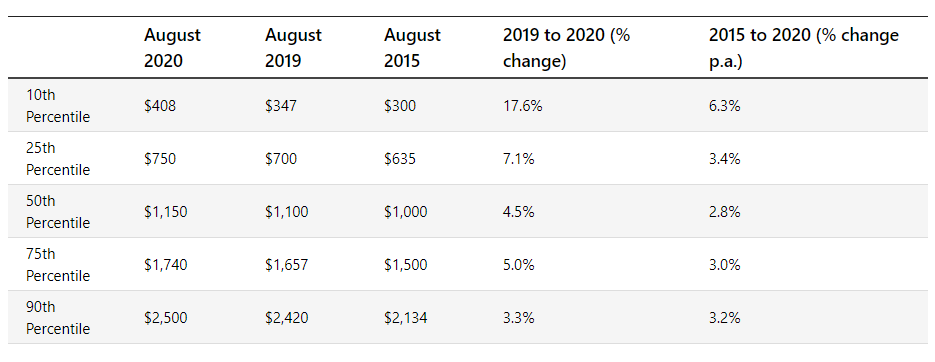The Labor-aligned think tank, the McKell Institute, has released a report entitled “Stuck in Neutral – The policy architecture driving slow wages growth in Australia”, which argues that the surge in temporary visas pre-COVID helped push down Australia’s wage growth:
Australia is a migration nation – it has benefited enormously from the great post-war immigration program…
A concerning recent trend in the immigration intake, however, has been an over-reliance on temporary migrants to fulfil less-skilled labour market functions, often in industries with a high prevalence of nefarious employment practices such as wage underpayment. An OECD report has found that Australia is host to one of the largest temporary migrant workforces in the developed world, second only to the US (OECD 2019). The report estimated that temporary migrants account for the equivalent of more than 200,000 full-time jobs…
In December 2019 there were more temporary visa holders living and working in Australia than at any time in the nation’s history…
The report of the Migrant Workers Taskforce, chaired by Professor Alan Fels, found that, as at mid-2018, the number of temporary visa holders with work rights had reached almost 880,000…
Since the 7-Eleven underpayment scandal was first reported in 2015, the underpayment of Australian workers, and foreign nationals working in Australia, has emerged as a major policy issue…
The McKell Institute’s 2020 report Blue Harvest (Cavanough and Wherrett 2020) documents instances of Working Holiday Makers in the horticultural industry of NSW being paid as little as $3 an hour, and subject to other forms of abuse. The Fair Work Ombudsman (FWO) routinely identifies instances of similarly egregious underpayment in the hospitality industry, particularly in segments of that industry that utilise temporary migrant workers…
There is growing evidence that certain categories of temporary entrants are disproportionately vulnerable to workplace exploitation, particularly underpayment. It is likely the vast majority of incidences of underpayment are not reported or resolved. Temporary entrants in some categories have a uniquely small degree of bargaining power in the workplace, leaving them exposed.
This is good to see. Hopefully the listless Labor Party will jump on the findings and start fighting the Morrison Government on immigration, including its recent work visa changes:
- Uncapping the number of hours international students can work while studying in Australia;
- Giving farmers a dedicated agricultural visa so that they can more easily hire foreign workers from South East Asian Nations;
- Giving easier access to UK working holidaymakers under the newly signed free trade agreement; and
- Adding an extra 22 occupations to the Priority Migration Skilled Occupation List, in turn giving these occupations priority processing for migration and travel exemptions.
That said, now that McKell acknowledges that temporary migration has been ruthlessly exploited by employers to undercut Australian workers and hold down wages, will it also accept that so-called ‘skilled’ visas are also used by employers to hold down the wages of skilled Australians?
RBA Governor Phil Lowe acknowledged this exact point last Thursday:
“The main effect of the closure of the borders on the labour market is that we can no longer tap the overseas labour market for areas where workers are in short supply.
“So, what used to happen before the pandemic is if there was a shortage in the labour market for a particular skill, firms could go overseas and tap the global labour market. And that meant that if there was very strong demand for workers of a particular skill, the price – the wage – didn’t really move very much because you could go and get workers from overseas.
“You can’t do that at the moment… And we’re starting to hear reports of wages moving for some of those jobs.
“I think if that [immigration] doesn’t happen, and we’re still in this position in a year’s time where we can’t get workers and skills are in short supply, then we will see more upward pressure on wages and inflation”.
In other words, preventing immigration from returning to turbo-charged pre-COVID levels is now central to achieving the RBA’s goal of higher wage growth. But if mass immigration is rebooted, this will increase the supply of labour, reduce worker bargaining power, keep unemployment elevated, and prevent Australian wages from rising.
To restore integrity to the visa system and protect Australian workers, all work visas (both temporary and permanent) should be required to be paid at least at the 75th percentile of earnings (preferably higher). This would equate to a minimum salary of $90,500 currently, which would rise over time with earnings:

The 75th percentile would set a migrant pay floor of $90,500, which would rise in line with earnings.
Setting a pay floor at this level would ensure that work visas are used sparingly by Australian businesses to employ only highly skilled migrants with specialised skills, not abused by businesses as a tool for undercutting local workers, reducing wage costs, and eliminating the need for training.
McKell and Labor should jump aboard this policy. It is a no-brainer.

